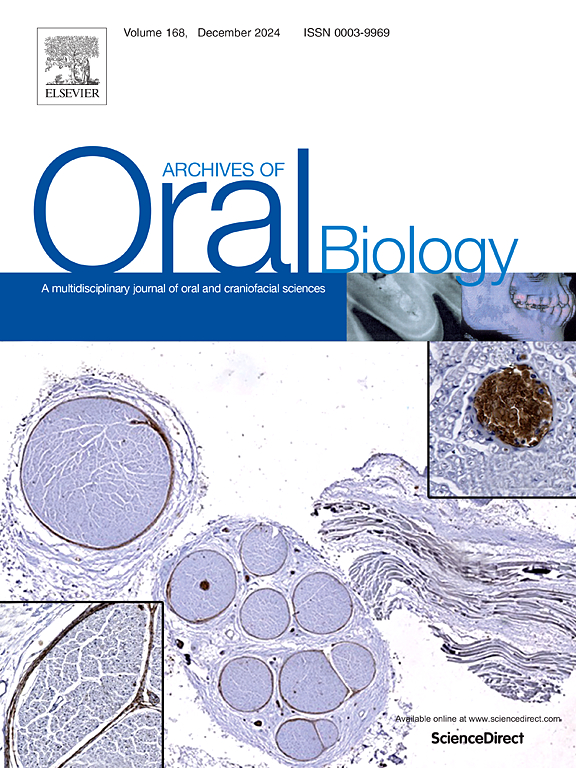体外证据表明抗逆转录病毒治疗(ART)可增强艾滋病毒感染者(PLHIV)和接受暴露前预防(PrEP)的个体对牙齿侵蚀的保护
IF 2.2
4区 医学
Q2 DENTISTRY, ORAL SURGERY & MEDICINE
引用次数: 0
摘要
目的评价HIV感染者(PLHIV)接受抗逆转录病毒治疗(ART)和HIV暴露前预防(PrEP)后唾液膜的保护能力。材料与方法16例受试者分为3组:对照组(n = 5;艾滋病毒阴性,未接受抗逆转录病毒治疗),艾滋病毒(n = 7;抗逆转录病毒治疗)和PrEP (n = 4;艾滋病毒阴性(PrEP)。为每组收集刺激唾液样本。釉质标本(n = 45)抛光后分组。样品进行了5次牙釉质膜形成循环(120 µL唾液,37°C, 2 h),每次循环后进行侵蚀(6 ml 1 %柠檬酸,25°C, 1 min, pH 3.6)。测定侵蚀循环前后的表面硬度(SH)、表面反射强度(SRI)、表面粗糙度(Sa)和钙释放量(CaR)。统计分析采用Kolmogorov-Smirnov检验检验正态性,SH和SRI采用单因素方差分析,Sa和CaR采用Kruskal-Wallis检验(α = 0.05)。结果sprep个体对SH侵蚀的保护作用最强,PLHIV次之(p = 0.016)。两组的保护效果均明显优于对照组,SRI值较高(p <; 0.05),牙釉质表面粗糙度较低(p = 0.001)。各组间钙释放量差异无统计学意义(p >; 0.05)。结论hiv感染者和服用PrEP的个体唾液膜对牙侵蚀的保护作用增强。本文章由计算机程序翻译,如有差异,请以英文原文为准。
In vitro evidence that Antiretroviral Therapy (ART) enhances protection against dental erosion in People Living with HIV (PLHIV) and individuals on Pre-Exposure Prophylaxis (PrEP)
Objective
This study aimed to evaluate the protective capacity of the salivary pellicle in people living with HIV (PLHIV) on antiretroviral therapy (ART) and individuals on pre-exposure prophylaxis (PrEP) for HIV.
Material and methods
Sixteen participants were divided into three groups: Control (n = 5; HIV-negative, not on ART), HIV (n = 7; PLHIV on ART), and PrEP (n = 4; HIV-negative, on PrEP). Stimulated saliva samples were pooled for each group. Enamel specimens (n = 45) were polished and allocated among the groups. Samples underwent five cycles of enamel pellicle formation (120 µL saliva, 37°C, 2 h), each followed by an erosive challenge (6 ml of 1 % citric acid, 25°C, 1 min, pH 3.6). Surface hardness (SH), surface reflection intensity (SRI), surface roughness (Sa), and calcium release (CaR) were measured before and after the erosive cycles. Statistical analyses included the Kolmogorov–Smirnov test for normality, one-way ANOVA for SH and SRI, and Kruskal–Wallis tests for Sa and CaR (α = 0.05).
Results
PrEP individuals exhibited the greatest protection against erosion in terms of SH, followed by PLHIV (p = 0.016). Both groups showed significantly better protection than the Control group, with higher SRI values (p < 0.05) and lower enamel surface roughness (p = 0.001). No significant differences were observed among the groups regarding calcium release (p > 0.05).
Conclusion
PLHIV and individuals on PrEP demonstrate enhanced protective properties of the salivary pellicle against dental erosion.
求助全文
通过发布文献求助,成功后即可免费获取论文全文。
去求助
来源期刊

Archives of oral biology
医学-牙科与口腔外科
CiteScore
5.10
自引率
3.30%
发文量
177
审稿时长
26 days
期刊介绍:
Archives of Oral Biology is an international journal which aims to publish papers of the highest scientific quality in the oral and craniofacial sciences. The journal is particularly interested in research which advances knowledge in the mechanisms of craniofacial development and disease, including:
Cell and molecular biology
Molecular genetics
Immunology
Pathogenesis
Cellular microbiology
Embryology
Syndromology
Forensic dentistry
 求助内容:
求助内容: 应助结果提醒方式:
应助结果提醒方式:


